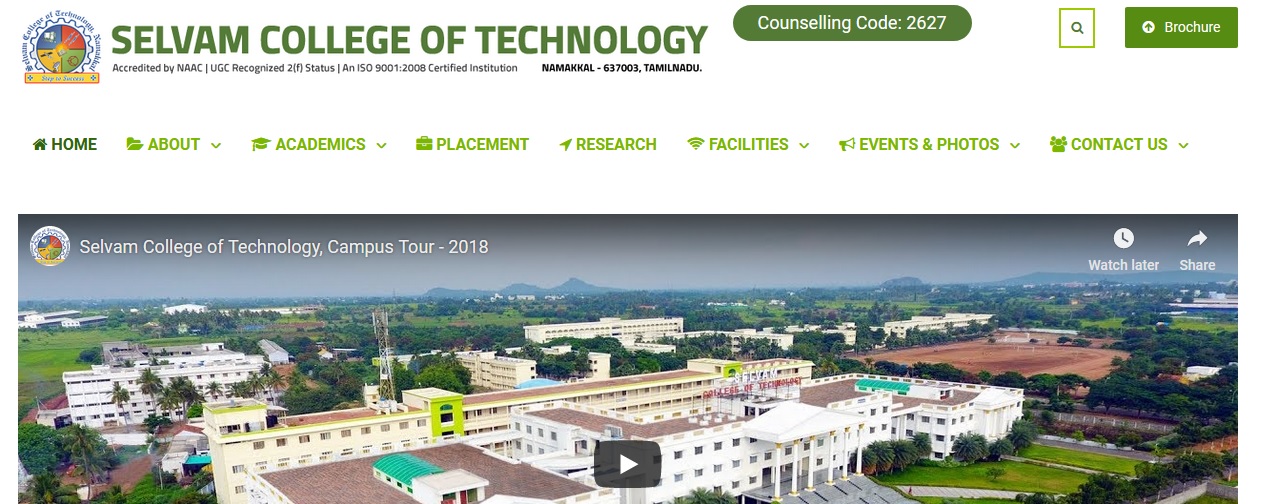Alternative Energy Sources B.E Question Bank : selvamtech.com
Name of the College : Selvam College of Technology
Subject Code/Name : 080120068 – Alternative Energy Sources
Dept : Mechanical Engineering
Degree : B.E
Year/Sem: : IV/VII
Website : selvamtech.com
Document Type : Question Bank
Download Model Question Paper : https://www.pdfquestion.in/uploads/selvamtech.com/3244-080120068%20-%20Alternative%20Energy%20Sources.pdf
Selvam Tech Alternative Energy Sources Question Paper
UNIT – 1
SOLAR ENERGY
1. Define solar constant.
It is the amount of energy received in unit time on a unit area perpendicular to the sun’s direction at the mean distance at the earth from the sun.
Related : Selvam College of Technology Electric Power Utilization And Energy Auditing B.E Question Bank : www.pdfquestion.in/3239.html
2. Define Beam radiation and diffuse radiation.
Beam radiation – Solar radiation that has not been absorbed or scattered and reaches the ground directly from the sun is called “direct radiation” (or) Beam radiation.
Diffuse radiation – It is that solar radiation received from the sun after its direction has been changed by reflection and scattering by the atmosphere.
3. Define hour angle.
It is the angle through which the earth must turn to bring the meridian of a point directly in the line with the sun’s rays. It is equivalent to 15 º per hour.

4. What is Zenith angle?
It is a vertical angle between. the sun’s rays and a line perpendicular to the horizontal plane through the point. It is 1t denoted as ?z and ?z = p/2 -a where a = solar altitude.
5. What is pyrheliometer and pyranometer?
1. Pyrheliometer is an instrument which measures the beam radiation.
2. Pyranometer is an instrument which measures the total or global radiation over a hemispherical field of view.
6. What is the use of sunshine recorder?
The duration of bright sunshine in a day is measured by means of a sunshine recorder.
7. Define Local Apparent Time.
The time used for calculating the hour angle ? is the local apparent time. It can be obtained from the standard observed on a clock by applying two corrections.
8. What is total radiation?
Beam and diffuse component of solar radiation are absorbed in flat plate type collectors.
9. What are the two types of flat plate type solar collector?
1. Non-concentrating or flat plate type solar collector.
2. Concentrating (focusing) type solar collector.
11. What is angle of latitude?
The angle between the equatorial plane of earth and the line joining the point on the earth’s surface and the earth’s centre
13. What are the two different types of air heaters?
1. Non-porous absorber.
2. Porous absorber.
14. What are the applications of solar air heaters?
It is used in:
1. Heating buildings
2. Drying agricultural product and lumber
3. Heating green houses
15. What are the different losses occurs during performance calculation of collector efficiency?
1. Conductive losses.
2. Convective losses.
3. Radiation losses.
UNIT – 2
WIND ENERGY
1. What is wind energy? Wind energy is an indirect form of solar energy.
2. Write down the applications of wind power.
1. Wind turbines to make electricity
2. Windmills for mechanical power
3. Wind pumps for water pumping or drainage, and
4. Sails to propel ships.
3. Mention characteristics of wind energy.
1. Wind-power systems do not pollute the atmosphere. .
2. Fuel provision and Transport are not required Wind-power systems.
3. Wind energy is a renewable source of energy.
4. Wind energy when produced on small scale is cheaper, but competitive with conventional power generating system when produced on a large scale.
4. Write down the characteristic of wind speed.
1. Cut-in wind speed: when the machine begins to produce power
2. Design wind speed: When the windmill reaches its maximum efficiency
3. Rated wind speed: when the machine reaches its maximum output power
4. Furling wind speed: when the machine furls to prevent damage at high wind speeds.
UNIT – 3
WIND ENERGY
1. What is Biomass and Biomass energy?
Biomass is organic matter produced by plants, both terrestrial (those grown on land) and aquatic (those grown in water). E.g., Wood and Agriculture residue. The energy obtained from biomass is called biomass energy.
2. What are the two major classifications of biomass resources?
1. Biomass from cultivated fields, crops, forests and harvested periodically.
2. Biomass derived from waste e.g., municipal waste, animal dung, forest waste, agricultural waste, bioprocess waste.
3. What is the scope of biomass energy?
1. Rural application of biomass energy.
2. Urban and industrial applications of biomass energy.
3. Biomass as a primary source for large scale electrical power generation.
4. What are the different types of biomass waste?
1 .Urban waste.
2 .Process waste.
3 .Agricultural waste.
4 .Forest waste.
5 .Fishery, Poultry.
6 .Animal and human excreta.
5. What are the major categories of biomass conversion process?
1. Direct combustion (Incineration)
2. Thermo chemical conversion.
3. Biochemical conversion.
UNIT – 4
OTEC, TIDAL, GEOTHERMAL AND HYDEL ENERGY
1. What is the principle of OTEC?
The ocean water gets heated up naturally due to solar radiation .The temperature of water near surface is higher than that of water. Significant amount of heat can be extracted from water by ocean thermal gradient principle of thermodynamics.
2. What are the different types of OTEC?
a) Open cycle (Claude cycle, Steam cycle)
b) Closed cycle (Anderson cycle, Vapour cycle)
3. What are the limitations of open cycle OTEC system?
a) Very large flow of ocean water in terms of and volume.
b) Cost of plant is high.
c) Turbine is physically large.
d) Cost of electrical energy from open cycle OTEC is very high.
4. What are the working fluids in closed cycle OTEC?
a) Ammonia (NH3)
b) Freon
c) Butane
5. What are the components of Tidal power plants?
1. The dam or dyke
2. Sluice ways
3. The power house